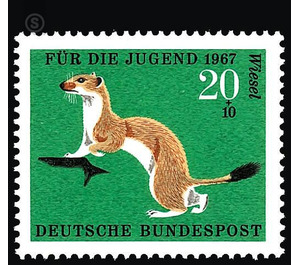For the youth Endangered animals - Germany / Federal Republic of Germany 1967 - 20 Pfennig
Theme: Animals
| Country | Germany / Federal Republic of Germany |
| Issue Date | 1967 |
| Face Value | 20.00 |
| Color | green |
| Perforation | K 14 |
| Printing Type | Multicolor offset printing |
| Stamp Type | Postage stamp |
| Item Type | Stamp |
| Chronological Issue Number | 420 |
| Chronological Chapter | GER-BRD |
| SID | 479782 |
| In 40 Wishlists | |
This is the sixth episode of the youth brands that have appeared since 1962. So far, they have shown butterflies, songbirds, fish, huntable birds, and mammals of the forest and mountains. The 1967 series is dedicated to fur animals. For the production of drafts five artists were invited, two of which were named by the German Hunting Association e.V. They were given the task to treat the rabbit, the weasel, the badger and the fox by drawing. Also the beaver could be shown. Paul Froitzheim, Dieter von Andrian, Gerhard Wawra, Paul W. Dahms and Michael Kiefer have each delivered a series with four values. Michael Kiefer added three variants to his proposals. All participants have endeavored to represent the animals in their typical body forms and in their characteristic behavior as they occur in the wild. Thus they fulfilled the one essential side of the task. For the brands are intended to introduce young people to the wonders of the animal world in our technically-civilized time. In addition, it must not be overlooked that the stamp must retain its typical face, that, while preserving the fidelity to nature, the figurative part in combination with lines of text and denomination must result in an unbroken whole. The naturalistic should not exceed the graphically strict framework, must not come from the photographic snapshot. The animals should therefore not be held in a random situation, including a part of the environment should be included in the picture. Rather, they should appear in a universal pose and best represent themselves statically without any accessory. If you look at the pictures in this way, you will soon see where the really successful services are to be found. The proposals of Paul Froitzheim seemed particularly successful to the art advisory committee, because in them both approaches were brought together to a convincing synthesis. The animals are impeccable and correctly represented from a scientific point of view. Some valuable hints were given, as every year, the experts of the Museum Koenig in Bonn, but also representatives of the German Hunting Association e.V., for which at this point again expressed the thanks. In addition to this correctness, which is recognized by a competent side, the chosen solutions have the advantage that the animals are largely placed in the given area and are scarcely sketched with precision. The child really gets to know her in her own way. At the same time, however, these marks are self-contained and accomplished graphic creations, perfectly matched in their colourfulness. Before the production of the printable final drawings, the program was changed insofar as the hamster was recorded instead of the badger. The stamps have been produced in the Bundesdruckerei Berlin in the process of multicolor offset printing.


